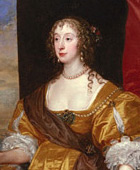Anne Killigrew was the daughter of Henry Killigrew and was born in London in 1660. She was characterized by one of her admireres as "a Grace for beauty and a Muse for wit." Her father was one of the prebendaries of Westminster some time before the restoration of Charles II.
Anne showed indications of genius very early and her father made sure to carefully cultivate it. She became celebrated in the arts of poetry and painting. She painted a portrait of the Duke of York, who later became James II, and his duchess, to whom she was a maid of honor. She also painted some historical pictues and some pieces of still life, for her own pleasure.
Anne was also known as a poet and was often comapred to Catharine Philips, the "Matchless Orinda". Not only did she share in her artistic talent, but also in the similarities of their lives.
Anne Killigrew was an exemplary woman of virtue and piety. Dryden speaks of her in the highest terms, and wrote a long ode to her memory, from which the following stanza is extracted:
"Now all those charms, that blooming grace,
The well-proportioned shape and beauteous face,
Shall never more be seen by mortal eyes:
In earth the much lamented virgin lies!
Nor was the cruel destiny content
to finish all the murder at a blow,
to snap at once her life and beauty too;
But, like a hardened felon, took a pride
to work more mischievously slow,
and plunder's first, and then destroyed.
Oh! double sacrilege on things divine,
To rob the relique and deface the shrine!
But thus Orinda died:
Heaven by the same disease did both translate,
As equal were their souls, as equal was their fate."
She died of smallpox in 1685 and was buried in the chapel of the Savoy hospital, on the north side of which is a plain monument of marble and freestone erected to her memory, and fixed in the wall, on which is a Latin inscription. |






